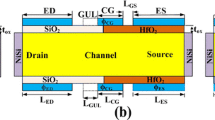Abstract
Ambipolarity in tunnel field-effect transistor (TFET) is a subject of grave concern in the current scenario of the semiconductor industry as this property of device limits its usability in CMOS circuit applications. In this concern, this paper presents a new approach to suppress the ambipolar behavior of dopingless TFET (DL TFET) by controlling the lateral band-to-band tunneling at the drain/channel interface. To execute this, a metal strip is embedded inside the oxide region between gate and drain terminals to modulate the energy bands for preventing the tunneling of charge carriers. The energy bands are widened at the drain-channel junction using this technique and correspondingly ambipolarity is reduced by a factor of \(10^{11}\). The variation in the energy bands is examined under different negative gate bias for the proposed device and conventional device which has shown that the energy barrier for the proposed device remains wider for different voltages under the influence of metal embedded. Alignment of the metal strip is varied to obtain the desired performance of the device. In this regard, optimization of work function and length of metal strip along with its position is demonstrated considering its impact on the ambipolar current and ON-state current, which gave 4.0 eV work function and 20 nm as the optimized work function and length of the metal strip, respectively.








Similar content being viewed by others
References
G.E. Moore, Cramming more components onto integrated circuits. Electron. Mag. 38, 114–117 (1965)
J.P. Colinge (ed.), FinFETs and Other Multi-Gate Transistors, vol. 73 (Springer, New York, 2008)
Q. Zhang, W. Zhao, A. Seabaugh, Low-subthreshold-swing tunnel transistors. IEEE Electron Device Lett. 27(4), 297–300 (2006)
Y. Khatami, K. Banerjee, Steep subthreshold slope n- and p-type tunnel-FET devices for low-power and energy-efficient digital circuits. IEEE Trans. Electron Devices 56(11), 2752–2761 (2009)
S. Mookerjea, S. Datta, Comparative study of Si, Ge and InAs based steep subthreshold slope tunnel transistors for 0.25 V supply voltage logic applications, in Device Research Conference, Santa Barbara, CA (2008), pp. 47–48
R. Gandhi, Z. Chen, N. Singh, K. Banerjee, S. Lee, Vertical Si-nanowire n-type tunneling FETs with low subthreshold swing (\(\le 50 \text{ mV/decade }\) ) at room temperature. IEEE Electron Device Lett. 32(4), 437–439 (2011)
A.C. Seabaugh, Q. Zhang, Low-voltage tunnel transistors for beyond CMOS logic. Proc. IEEE. 98(12), 2095–2110 (2010)
R. Asra, M. Shrivastava, K.V.R.M. Murali, R.K. Pandey, H. Gossner, V.R. Rao, A tunnel FET for \(\text{ V }_{\text{DD}}\) scaling below 0.6 V with a CMOS-comparable performance. IEEE Trans. Electron Devices 58(7), 1855–1863 (2011)
A.R. Trivedi, M.F. Amir, S. Mukhopadhyay, Ultra-low power electronics with Si/Ge tunnel FET, in Design, Automation and Test in Europe Conference and Exhibition, Dresden, (2014), pp. 1–6
A.M. Ionescu, H. Riel, Tunnel field-effect transistors as energyefficient electronic switches. Nature 479(7373), 329–337 (2011)
K. Boucart, A.M. Ionescu, Double-gate tunnel TFET with high-\(\kappa\) gate dielectric. IEEE Trans. Electron Devices 54(7), 1725–1733 (2007)
B. Raad, K. Nigam, D. Sharma, P. Kondekar, Dielectric and work function engineered TFET for ambipolar suppression and RF performance enhancement. Electron. Lett. 52(9), 770–772 (2016)
K. Boucart, A.M. Ionescu, Length scaling of the double gate tunnel FET with a high-\(\kappa\) gate dielectric. Solid State Electron. 51(11–12), 1500–1507 (2007)
K.K. Bhuwalka, J. Schulze, I. Eisele, Scaling the vertical tunnel FET with tunnel bandgap modulation and gate workfunction engineering. IEEE Trans. Electron Devices 52(5), 909–917 (2005)
K.K. Bhuwalka, M. Born, M. Schindler, M. Schmidt, T. Sulima, I. Eisele, P-channel tunnel field-effect transistors down to sub-50 nm channel lengths. Jpn. J. Appl. Phys. 45(4B), 3106–3109 (2006) (Part 1)
M.J. Kumar, S. Janardhanan, Doping-less tunnel field effect transistor: design and investigation. IEEE Trans. Electron Devices 60(10), 3285–3290 (2013)
M.S. Ram, D.B. Abdi, Dopingless PNPN tunnel FET with improvedperformance: design and analysis. Superlattices Microstruct. 82, 430–43 (2015)
A. Hraziia, C. Andrei, A. Vladimirescu, A. Amara, C. Anghel, An analysis on the ambipolar current in Si double-gate tunnel FETs. Solid State Electron. 70, 67–72 (2012)
V. Vijayvargiya, S.K. Vishvakarma, Effect of drain doping profile on double-gate tunnel field-effect transistor and its influence on device RF performance. IEEE Trans. Nanotechnol. 13(5), 974–981 (2014)
B.R. Raad, D. Sharma, K. Nigam, P. Kondekar, Physics-based simulation study of high-performance gallium arsenide phosphideindium gallium arsenide tunnel field-effect transistor. IET Micro Nano Lett. 11(97), 366–368 (2016)
H. Wang, S. Chang, Y. Hu, H. He, J. He, Q. Huang, F. He, G. Wang, A novel barrier controlled tunnel FET. IEEE Electron Device Lett. 35(7), 798–800 (2014)
W.Y. Choi, W. Lee, Hetero-gate-dielectric tunneling field-effect transistors. IEEE Trans. Nanotechnol. 57(9), 2317–2319 (2010)
B.R. Raad, K. Nigam, D. Sharma, P.N. Kondekar, Performance investigation of bandgap, gate material work function and gate dielectric engineered TFET with device reliability improvement. Superlattices Microstruct. 94, 138–146 (2016)
D.B. Abdi, M. Jagadesh Kumar, Controlling ambipolar current in tunneling FETs using overlapping gate-on-drain. IEEE J. Electron Devices Soc. 2(6), 187–190 (2014)
S. Sahay, M.J. Kumar, Controlling the drain side tunneling width to reduce ambipolar current in tunnel FETs using heterodielectric BOX. IEEE Trans. Electrons Devices 62(11), 3882–3885 (2015)
S. Tirkey, D. Sharma, D.S. Yadav, S. Yadav, Analysis of a novel metal implant junctionless tunnel FET for better DC and analog/RF electrostatic parameters. IEEE Trans. Electrons Devices 64(9), 3943–3950 (2017)
B.R. Raad, S. Tirkey, D. Sharma, P.N. Kondekar, A new design approach of dopingless tunnel FET for enhancement of device characteristics. IEEE Trans. Electrons Devices 64(4), 1830–1836 (2017)
S. Tirkey, D. Sharma, B.R. Raad, D.S. Yadav, Introduction of a metal strip in oxide region of junctionless tunnel field-effect transistor to improve DC and RF performance. J. Comput. Electron. 16(3), 714–720 (2017)
P. Ranade, H. Takeuchi, T.J. King, C. Hu, Work function engineering of molybdenum gate electrodes by nitrogen implantation. Electrochem. Solid State Lett. 4(11), G85–G87 (2001)
ATLAS Device Simulation Software, Silvaco Int., Santa Clara, CA, USA (2014)
Author information
Authors and Affiliations
Corresponding author
Rights and permissions
About this article
Cite this article
Tirkey, S., Yadav, D.S. & Sharma, D. Controlling ambipolar current of dopingless tunnel field-effect transistor. Appl. Phys. A 124, 809 (2018). https://doi.org/10.1007/s00339-018-2237-6
Received:
Accepted:
Published:
DOI: https://doi.org/10.1007/s00339-018-2237-6




